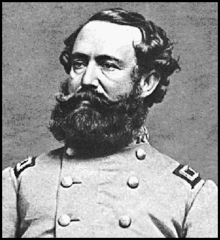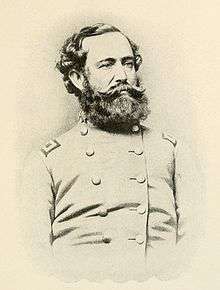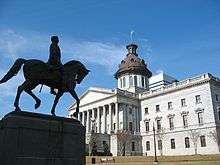Wade Hampton III
| Wade Hampton III | |
|---|---|
 Wade Hampton during the Civil War | |
| United States Senator from South Carolina | |
|
In office March 4, 1879 – March 3, 1891 | |
| Preceded by | John J. Patterson |
| Succeeded by | John L. M. Irby |
| 77th Governor of South Carolina | |
|
In office December 14, 1876 – February 26, 1879 | |
| Lieutenant | William Dunlap Simpson |
| Preceded by | Daniel Henry Chamberlain |
| Succeeded by | William Dunlap Simpson |
| Member of the South Carolina Senate from Richland District | |
|
In office November 22, 1858 – October 8, 1861 | |
| Preceded by | John Smith Preston |
| Succeeded by | Edward John Arthur |
| Member of the South Carolina House of Representatives from Richland District | |
|
In office November 22, 1852 – November 22, 1858 | |
| Personal details | |
| Born |
March 28, 1818 Charleston, South Carolina |
| Died |
April 11, 1902 (aged 84) Columbia, South Carolina |
| Political party | Democratic |
| Alma mater | South Carolina College |
| Profession | planter, soldier, politician |
| Committees | United States railroad commissioner 1893–1897 |
| Military service | |
| Allegiance |
|
| Service/branch |
|
| Years of service | 1861–1865 |
| Rank |
|
| Commands |
Hampton's Legion Cavalry Corps, Army of Northern Virginia |
| Battles/wars | American Civil War |
Wade Hampton III (March 28, 1818 – April 11, 1902) came from a wealthy planter family and shortly before the war was one of the largest slaveholders in the Southeast. He was elected to the state legislature. During the American Civil War, he served as a Confederate cavalry leader, reaching the rank of lieutenant general. In the postwar years, he returned to serve as a Democratic Party politician from South Carolina.
Near the end of the Reconstruction, Hampton was elected as 77th Governor of South Carolina, serving 1876-1879, and later was elected as a U.S. Senator. His campaign as governor was marked by extensive violence by the Red Shirts, a paramilitary group that served the Democratic Party by disrupting elections and suppressing black voting in the state. They contributed to the Democrats regaining control of the state government in this period.
Early life and career

Wade Hampton III was born in 1818 at 54 Hasell St. in Charleston, South Carolina, the eldest son of Wade Hampton II (1791–1858), known as "Colonel Wade Hampton", and Ann (née Fitzsimmons) Hampton. His mother was from a wealthy family in Charleston.[1] After the War of 1812, his father had built his own fortune on land speculation in the Southeast. Together with owning extensive plantation lands in South Carolina and Mississippi, he was said to own the highest number of slaves in the South (more than 3,000).
The senior Hampton was an officer of dragoons in the War of 1812, and an aide to General Andrew Jackson at the Battle of New Orleans. The boy was the grandson of Wade Hampton (1754–1835), lieutenant colonel of cavalry in the American War of Independence, member of the U.S. House of Representatives, and brigadier general in the War of 1812. Wade III's uncle by marriage, James Henry Hammond, was elected to the U.S. House of Representatives and as Governor of South Carolina. In the late 1850s he was elected to the U.S. Senate.
Wade Hampton III grew up in a wealthy planter family, receiving private instruction. He had four younger sisters. His was an active outdoor life; he rode horses and hunted, especially at his family's North Carolina summer retreat, High Hampton.[2] The youth was known for taking hunting trips alone into the woods, hunting American black bears with only a knife. Some accounts credit him with killing as many as 80 bears.[3]
In 1836 Hampton graduated from South Carolina College (now the University of South Carolina), and was trained for the law, although he never practiced. His father assigned certain plantations to him to manage in South Carolina and Mississippi.[1] The younger man also became active in Democratic state politics.
He was elected to the South Carolina General Assembly in 1852 and served as a state Senator from 1858 to 1861. After Hampton's father died in 1858, the son inherited his vast fortune, the plantations, and one of the largest holdings of slaves in the South.
Civil War

Although Hampton was conservative on issues of secession and slavery, and he had opposed the division of the Union as a legislator, when war began, he was loyal to his state. He resigned from the US Senate and enlisted at the age of 42 as a private in the South Carolina Militia. The governor of South Carolina insisted that Hampton accept a colonel's commission.
Although he had no military experience, his years of managing plantations and serving in state government were considered signs of leadership. As was also the case in northern regiments, the elite were commissioned based on their social standing and were also expected to finance military units. Hampton organized and partially financed the unit known as "Hampton's Legion," which consisted of six companies of infantry, four companies of cavalry, and one battery of artillery. He personally paid for all the weapons for the Legion.
Hampton was a natural cavalryman—brave, audacious, and already a superb horseman. Of officers without previous military experience, he was one of three to achieve the rank of lieutenant general, the others being Nathan Bedford Forrest and Richard Taylor.
Hampton first saw combat in July 1861, at the First Battle of Manassas, where he deployed his Legion at a decisive moment, giving the brigade of Thomas J. "Stonewall" Jackson time to reach the field. He was wounded the first of five times during the war when he led a charge against a federal artillery position, and a bullet creased his forehead.
On May 23, 1862, Hampton was promoted to brigadier general, while commanding a brigade in Stonewall Jackson's division in the Army of Northern Virginia. In the Peninsula Campaign, at the Battle of Seven Pines on May 31, 1862, he was severely wounded in the foot. He remained on his horse while the foot was treated, still under fire. Hampton returned to duty in time to lead a brigade at the end of the Seven Days Battles, although the brigade was not significantly engaged.
After the Peninsula Campaign, General Robert E. Lee reorganized his cavalry forces as a division under the command of J.E.B. Stuart, who selected Hampton as his senior subordinate, to command one of two cavalry brigades. During the winter of 1862, around the Battle of Fredericksburg, Hampton led a series of cavalry raids behind enemy lines and captured numerous prisoners and supplies without suffering any casualties, earning a commendation from General Lee. In November 1862, he captured 137 men of the 3rd Pennsylvania Cavalry at Hartwood Presbyterian Church.[4] During the Battle of Chancellorsville, Hampton's brigade was stationed south of the James River, and did engage in the action, which all took place to the north.
In the Gettysburg Campaign, Hampton was slightly wounded in the Battle of Brandy Station, the war's largest cavalry battle. His brigade participated in Stuart's wild adventure to the northeast, swinging around the Union army and losing contact with Lee. Stuart and Hampton reached the vicinity of Gettysburg, Pennsylvania, late on July 2, 1863. While just outside town, Hampton was confronted by a Union cavalryman pointing a rifle at him from 200 yards. Hampton charged the trooper before he could fire his rifle, but another trooper blindsided Hampton with a saber cut to the back of his head. On July 3, Hampton led the cavalry attack to the east of Gettysburg, attempting to disrupt the Union rear areas, but colliding with Union cavalry. He received two more saber cuts to the front of his head, but continued fighting until he was wounded again with a piece of shrapnel to the hip. He was carried back to Virginia in the same ambulance as General John Bell Hood.
On August 3, 1863, Hampton was promoted to major general and received command of a cavalry division. As his wounds from Gettysburg were slow in healing, he could not return to duty until November. During the Overland Campaign of 1864, J.E.B. Stuart was killed at the Battle of Yellow Tavern and Hampton was given command of the Cavalry Corps on August 11, 1864. He distinguished himself in his new role at the bloody Battle of Trevilian Station, defeating Maj. Gen. Philip Sheridan's cavalry. For the rest of the war, Hampton lost no cavalry battles. In September, Hampton conducted what became known as the "Beefsteak Raid," where his troopers captured over 2400 head of cattle and more than 300 prisoners behind enemy lines.
In October 1864, near Petersburg, Virginia, Hampton sent his son, T. Preston Hampton, a lieutenant serving as one of his aides, to deliver a message. Shortly afterward, Hampton and his other son, Wade IV, rode in the same direction. Before traveling 200 yards, they came across Preston lying on the ground; he was fatally wounded and soon died. As young Wade dismounted, he was also shot but survived.[5]
While Lee's army was bottled up in the Siege of Petersburg, in January 1865, Hampton returned to South Carolina to recruit soldiers. He was promoted to lieutenant general on February 14, 1865, but eventually surrendered to the Union along with General Joseph E. Johnston's Army of Tennessee at Bennett Place in Durham, North Carolina. Hampton was reluctant to surrender, and nearly got into a personal fight with Union Brig. Gen. Judson Kilpatrick (often called "Kill-Cavalry") at the Bennett Farm.
Postwar years
After the war, Hampton suffered devastating financial losses. His boyhood home, Millwood, near Columbia, was burned by Maj. Gen. William T. Sherman's Union soldiers. He later was expected to spend monies to help supply Union soldiers during Reconstruction. He was not compensated when his thousands of slaves were emancipated. Although Hampton retained his plantations, his overseers found it more difficult to turn a profit in a free labor system. The southern economy was low for years.
Together with Lt. Gen. Jubal A. Early, Hampton became a proponent of the Lost Cause movement. He worked to explain the Confederacy's loss of the war and deeply regretted the loss of the secure life he had before the war. He strongly resented the use of black troops as part of the Federal government's occupying force in South Carolina.

Hampton was offered the nomination for governor in 1865, but refused because he believed Northerners would be suspicious of a former Confederate general seeking political office only months after the end of the Civil War. Hampton campaigned to ask supporters not to vote for him in the gubernatorial election. In 1868, he became the chairman of the state Democratic Party central committee. That year, the Radical Republicans took the election.
He essentially ceased most overt political activity until 1876. Like many other elite Southerners, Hampton gave tacit support to the Ku Klux Klan, which had independent chapters of insurgents arising throughout the South. He helped raise money for legal defense funds after the Federal government started to enforce anti-Klan legislation of 1870 and 1871 to suppress the violence of its members against freedmen and white Republicans. He was not known to have active involvement within the organization.[6] Hampton supported Matthew Calbraith Butler in the Union Reform campaign of 1870.
Other insurgent groups rapidly formed to replace the KKK. In South Carolina and other states, groups of men calling themselves "rifle clubs" formed to act as law enforcement in the years after the war. In 1876, an estimated 20,000 men in South Carolina were members of rifle clubs in the state.[7] Political campaigns were increasingly violent as whites tried to suppress black voting.
Beginning in the mid-1870s, the Democratic paramilitary group known as the Red Shirts developed chapters in most South Carolina counties (they had originated in Mississippi), and were similar to rifle clubs. These groups acted as "the military arm of the Democratic Party."[8] They marched in parades during campaigns, openly disrupted Republican meetings, and worked to suppress black voting in the state by violence and intimidation.[9] By 1876, there were estimated to be 20,000 men who were members of rifle clubs in the state.[7]
Hampton opposed the Radical Republicans' Reconstruction policies in the South. He re-entered South Carolina politics in 1876, running in opposition to those policies. Hampton, a Democrat, ran against Republican incumbent governor Daniel Henry Chamberlain.
Hampton used Grace Peixotto's "Big Brick House," a prominent brothel located at 11 Fulton Street in Charleston, to assure complete privacy for the Red Shirts' meetings; it mainly served as campaign headquarters.[10] The 1876 South Carolina gubernatorial election is thought to be the bloodiest in the history of the state. The Red Shirts had used violence in every county to suppress black Republican voting. "An anti-Reconstruction historian later estimated that 150 Negroes were murdered in South Carolina during the campaign."[11]
Both parties claimed victory. For more than six months, there were two legislatures in the state, both claiming to be authentic. Eventually, the South Carolina Supreme Court ruled that Hampton was the winner of the election. The election of the first Democratic governor in South Carolina since the end of the Civil War. The national election of Rutherford B. Hayes as President was settled by a compromise among Democrats, by which the national party agreed to end formally the Reconstruction era. In 1877 Hayes ordered the withdrawal of federal troops from the South, essentially leaving freedmen to deal with whites on their own.
After the election, Hampton became known as the "Savior of South Carolina," and among those Democrats elected who were called "Redeemers." He was re-elected in 1878; the Red Shirts gave support but less violence was required.[9] Two days later, he was thrown from a mule while deer hunting and broke his right leg. Several weeks later, his right leg was amputated due to complications arising from this injury.
Despite refusing to announce his candidacy for the Senate, Hampton was elected to the United States Senate by the General Assembly on the same day as his leg was amputated. He resigned from the governorship to serve two terms in the Senate, until 1891. He was among Bourbon Democrats who appealed to some freedmen in support of his win.[12] John L. M. Irby won the seat in the state elections of 1890.
Later years
From 1893 to 1897, Hampton served as United States Railroad Commissioner, appointed by President Grover Cleveland. In 1899, his home in Columbia, was destroyed by fire. An elderly man, he then had limited funds and few means to find a new home. Over his strong protests, a group of friends raised enough funds to build him one.
He was a hereditary member of the South Carolina Society of the Cincinnati.
Personal
In 1838, Hampton married Margaret Preston (1818-1852). Their children were: Wade Hampton IV (1840-1879), Thomas Preston Hampton (1843-1864, killed in the war), Sarah Buchanan Hampton (1845-1886), John Preston Hampton (1846-1847), and Harriet Flud Hampton (1848-1853).
In 1858, Hampton III married Mary Singleton McDuffie (1830-1874). Their children were: George McDuffie Hampton (1859-1917), Mary Singleton "Daisy" Hampton (1861-1934), Alfred Hampton (1863-1942), and Catherine Fisher Hampton (born and died 1867)
In 1890, Hampton's niece Caroline, an operating room nurse, married William Halsted, later known as the "father of American surgery" for his contributions. He had developed the surgical glove to try to protect Caroline's skin from the harsh surgical sterilization chemicals.[13]
Wade Hampton died in Columbia. He is buried there in Trinity Cathedral Churchyard.
Legacy and honors

Statues of him were erected in the South Carolina State House building and in the United States Capitol. An equestrian statue by Frederick W. Ruckstull was erected on the grounds of the S.C. state capitol in Columbia, in 1906.
In the wake of the June 17, 2015, massacre at the Charleston Emanuel African Methodist Episcopal Church by white supremacist Dylann Roof, there was a push to remove Confederate symbols in the United States Capitol, including the Hampton statuel.[14] Congressional representatives voted to retain the statues.[15]
To honor Hampton for his leadership in the Civil War and the "redemption" of the state from Reconstruction-era reforms, the General Assembly created Hampton County from Beaufort County in 1878. The town of Hampton Courthouse, later shortened to Hampton, was incorporated on December 23, 1879, to serve as the county seat of Hampton County.
Across South Carolina, many towns and cities renamed streets for him. At least eight municipalities in South Carolina have a street named "Wade Hampton" (Beaufort, Charleston, Duncan, Greenville, Greer, Hampton, Taylors, and Walterboro) and approximately 47 towns in the state have streets named "Hampton". Two high schools in South Carolina are named Wade Hampton High School: in Greenville and in Varnville. A residence hall at Hampton's alma mater, the University of South Carolina, was named for him.
A Hampton Park was dedicated in Charleston and another in Columbia in his honor. The historic Hampton Heights neighborhood in Spartanburg is named after him. In 1964, Wade Hampton Academy was started in Orangeburg, considered a segregation academy. The school merged with Willington Academy in 1986 to become Orangeburg Preparatory Schools, Inc.
In 1913, Judge John Randolph Tucker named the Wade Hampton Census Area in Alaska to commemorate his father-in-law (it was renamed Kusilvak Census Area in 2015).[16]
An artillery battery was named after Wade Hampton at Fort Crockett, built on Galveston Island, Texas. The Wade Hampton Battery was one of four coastal artillery batteries and contained two 10-inch guns. During World War II, the SS Wade Hampton, a Liberty ship named in honor of the general, was sunk off the coast of Greenland by a German U-boat.
In Greenville County, South Carolina, the section of U.S. Route 29 that connects the city of Greenville to Spartanburg is called Wade Hampton Boulevard. There is also a fire district (Wade Hampton Fire Department) named in his honor placed on the east side of Greenville, adjoining the Greenville city limits, which include Wade Hampton High School.
In fiction
In Margaret Mitchell's novel Gone with the Wind, Scarlett O'Hara's first husband, Charles Hamilton, serves in Hampton's regiment. As it was fashionable (according to Mitchell) to name baby boys after their fathers' commanding officers, Scarlett's son by Charles is named Wade Hampton Hamilton. In the film version of Gone With The Wind, the letter sent to Scarlett advising her of Charles' death is shown to be signed by Hampton.
In the North and South trilogy by John Jakes, the character Charles Main serves with Hampton's cavalry throughout the Civil War.
Hampton appears in a small role in How Few Remain, the first novel in Harry Turtledove's Southern Victory Series, an alternate history in which the South wins the American Civil War. Later in the series, in the novel American Empire: Blood and Iron, Hampton's fictional grandson Wade Hampton V appears as a character.
Hampton is mentioned in Chapter 14, Section V of Go Set a Watchmanby Harper Lee, when Jean Louise's Uncle Jack is trying to get her to understand her father Atticus's actions regarding the citizens' committee after the Brown v Board of Education 1954 Supreme Court decision.
See also
Notes
- 1 2 Tagg, p. 359.
- ↑ High Hampton history.
- ↑ Ackerman, p. 16, cites Theodore Roosevelt's The Wilderness Hunter for the figure of 80. Although Ackerman suggests 80 may be exaggerated, Hampton was considered "an excellent and fearless hunter".
- ↑ John N. Pearce (February 1989). "National Register of Historic Places Inventory/Nomination: Hartwood Presbyterian Church" (PDF). Virginia Department of Historic Resources.
- ↑ New York Times, June 27, 1897.
- ↑ Andrew, Rod Jr., Wade Hampton: Confederate Warrior to Southern Redeemer, University of North Carolina Press, 2008, pages 343-4
- 1 2 Walter Brian Cisco, Wade Hampton: Confederate Warrior, Conservative Statesman, Potomac Books, 2004, p. 260
- ↑ George C. Rable, But There Was No Peace: The Role of Violence in the Politics of Reconstruction, Athens: University of Georgia Press, 1984, p. 132
- 1 2 Charles Lane, The Day Freedom Died, (2008) p. 247
- ↑ Jones 2006: 22-23
- ↑ Nicholas Lemann, Redemption: The Last Battle of the Civil War, New York: Farrar Straus & Giroux, Paperback, 2007, p.174
- ↑ General Wade Hampton III, C.S.A. (1818-1902)
- ↑ The Four Founding Physicians Johns Hopkins Medicine web site. Retrieved May 13, 2016.
- ↑ "Search for Confederate symbols finds them aplenty in Washington, DC", New York Times
- ↑ http://abcnews.go.com/Politics/leaders-content-leave-confederate-statues-us-capitol-flag/story?id=31980551 "Leaders content to leave Confederate statues in US Capitol"], ABC News
- ↑ Demer, Lisa (July 2, 2015). "Wade Hampton no more: Alaska census area named for confederate officer gets new moniker". Alaska Dispatch News. Retrieved July 2, 2015.
References
- Ackerman, Robert K. Wade Hampton III. Columbia: University of South Carolina Press, 2007. ISBN 978-1-57003-667-5.
- Eicher, John H., and David J. Eicher, Civil War High Commands. Stanford: Stanford University Press, 2001. ISBN 978-0-8047-3641-1.
- Jarrell, Hampton M. Wade Hampton and the Negro: The Road Not Taken. Columbia: University of South Carolina Press, 1969. OCLC 2774253.
- Rod, Andrew, Jr. Wade Hampton: Confederate Warrior to Southern Redeemer (2008)
- Sifakis, Stewart. Who Was Who in the Civil War. New York: Facts On File, 1988. ISBN 978-0-8160-1055-4.
- Tagg, Larry. The Generals of Gettysburg, Campbell, CA: Savas Publishing, 1998. ISBN 1-882810-30-9.
- Warner, Ezra J. Generals in Gray: Lives of the Confederate Commanders. Baton Rouge: Louisiana State University Press, 1959. ISBN 978-0-8071-0823-9.
- Wells, Edward L. Hampton and Reconstruction. Columbia, SC: The State Co., 1907. OCLC 2339541.
Further reading
- Cisco, Walter Brian. Wade Hampton: Confederate Warrior, Conservative Statesman. Washington, DC: Potomac Books, 2004. ISBN 1-57488-626-6.
- Longacre, Edward G. Gentleman and Soldier: A Biography of Wade Hampton III. Lincoln: University of Nebraska Press, 2009. ISBN 978-0-8032-1354-8.
- Meynard, Virginia G. The Venturers, The Hampton, Harrison and Earle Families of Virginia, South Carolina, and Texas, Easley, SC: Southern Historical Press, Inc., 1981. ISBN 0-89308-241-4.
- Swank, Walbrook Davis. Battle of Trevilian Station: The Civil War's Greatest and Bloodiest All Cavalry Battle, with Eyewitness Memoirs. Shippensburg, PA: W. D. Swank, 1994, ISBN 0-942597-68-0.
- Wellman, Manly Wade. Giant in Gray: A Biography of Wade Hampton of South Carolina. Dayton, OH: Press of Morningside Bookshop, 1988. ISBN 0-89029-054-7
- Willimon, William H. Lord of the Congaree, Wade Hampton of South Carolina. Columbia, SC: Sandlapper Press, 1972. ISBN 0-87844-010-0.
- Wittenberg, Eric J. The Battle of Munroe's Crossroads and the Civil War's Final Campaign. El Dorado Hills, CA: Savas Beatie, 2006. ISBN 1-932714-17-0.
External links
| Wikimedia Commons has media related to Wade Hampton III. |
| Wikisource has original works written by or about: Wade Hampton III |
- Chisholm, Hugh, ed. (1911). "Hampton, Wade". Encyclopædia Britannica (11th ed.). Cambridge University Press.
- Online biography
- The Citadel Archives: Hampton, Wade, 1818-1902
- United States Congress. "Wade Hampton III (id: H000141)". Biographical Directory of the United States Congress.
| Political offices | ||
|---|---|---|
| Preceded by Daniel Henry Chamberlain |
Governor of South Carolina 1877–1879 |
Succeeded by William Dunlap Simpson |
| United States Senate | ||
| Preceded by John J. Patterson |
U.S. Senator (Class 3) from South Carolina 1879–1891 Served alongside: Matthew C. Butler |
Succeeded by John L. M. Irby |

